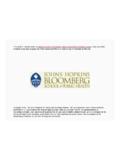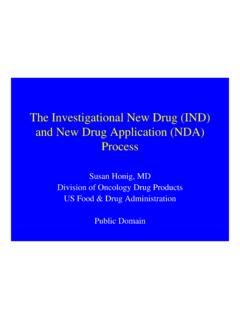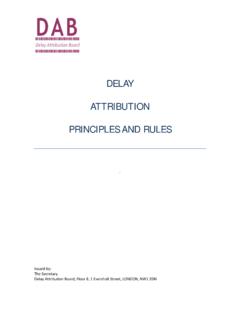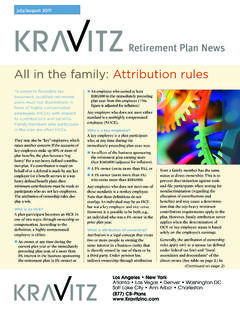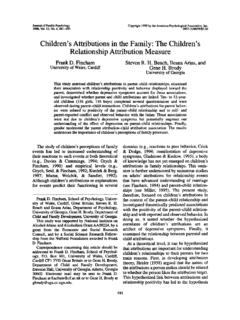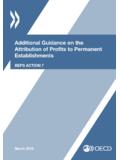Transcription of This work is licensed under a Creative Commons Attribution ...
1 This work is licensed under a Creative Commons Attribution -NonCommercial-ShareAlikeLice nse. Your use of this material constitutes acceptance of that license and the conditions of use of materials on this 2006, The Johns Hopkins University, Patrick Breysse, and Peter S. J. Lees. All rights reserved. Use of these materials permitted only in accordance with license rightsgranted. Materials provided AS IS ; no representations or warranties provided. User assumes all responsibility for use, and all liability related thereto, and must independently review all materials for accuracy and efficacy. May contain materials owned by others. User is responsible for obtaining permissions for use from third partiesas and VaporsPatrick N. Breysse, PhD, CIHP eter Lees, PhD, CIHJ ohns Hopkins UniversitySection AIntroduction and DefinitionsGases and VaporsDefinition of Gas Gas Normal formless state of matter which at room temperature and pressure has low density/viscosity and readily and uniformly distributes itself throughout any container Can be organic or inorganic Examples: O2, SO2, O3, NO2, formaldehyde (HCOH), methane (CH4) 4 Gases and VaporsDefinition of Vapor Vapor Gaseous form of a substance which coexists as a solid or liquid at normal temperature and pressure Can be organic or inorganic Examples: Hg, H2O, benzene (C6H6), acetone (C3H6O), ethanol (C2H6O)5 Gases and VaporsConditions STP (standard temperature and pressure) 0 C and 760 mmHg (32 F and inHg; 1 mole of any gas occupies liters @ STP) NTP (normal temperature and pressure) 25 C & 760 mmHg; 77 F and inHg.
2 1 mole of any gas occupies liters @ NTP6 Vapor Pressure Vapor pressureis the pressure exerted when a solid or liquid is at equilibrium with its own vapor; the higher the vapor pressure, the more volatile the chemical Vapor pressure is measured in mmHg and is temperature dependent; the higher the temperature, the higher the vapor pressure (and equilibrium concentration)7 Measuring Vapor PressureU-tube manometerconnected to a flask8 Vapor Pressure Given two substances of the same volume, which one has more potential hazard? Example: Motor oil vs. ether? Ether has more potential hazard than motor oil due to its high vapor pressure and volatility 9 Health Effects Gases and vapors are molecules, and as such, behavior is governed in large part by diffusion Exposure (absorption) in respiratory system is largely dependent on gas solubility in mucous membranes Gases and vapors can be local irritants or systemic toxins distributed in solution via blood and lymph10 Examples of Health Effects Asphyxiants:Carbon dioxide, carbon monoxide Irritants:Chlorine, formaldehyde Anesthetics:Toluene, benzene Hepatotoxins:Carbon tetrachloride, chlorobenzene Nephrotoxins:Toluene, xyleneContinued11 Examples of Health Effects Neurotoxins:Carbon disulfide Hematopoietictoxins:Benzene, carbon monoxide Pulmonarytoxins:Nitrogen dioxide, phosgene Carcinogens.
3 Benzene, vinyl chloride monomer12 Section BGas LawsBoyle s Law At constant temperature, the volume (V) occupied by a gas is inversely proportional to the pressure (P); as the pressure goes up, the volume of the gas goes down and vice versavolume and pressure final are V&Pvolume and pressure initial are V&P : where;PPVV & VP VP2 21 112212211==Continued14 Boyle s Law Example: If 400 ml of O2is collected at 780 mmHg, what volume will the gas occupy if the pressure is changed to 740 mmHg?Xml)(740mmHg)(400ml)(780mmHg)(=(740 mmHg)400ml)(780mmHg)(Xml=422mlX=15 Charles Law At constant pressure, the volume of a gas is directly proportional to its absolute temperature (Kelvin): Where: T1and V1= initial temperature and volume, and T2and V2= final temperature and volume2211 TVTV=Continued16 Charles Law Example: At a constant pressure, what is the volume of a gas at 20 C if the gas occupied 50 ml @ 0 C?ml X ml 50 253K273K = ) (50ml Xml= =17 Boyle s and Charles Laws Combined The density of a gas is related to the volume, temperature, and pressure As volume increases, density decreases proportionally; density varies inversely with volume, directly with pressure, and inversely with absolute temperatureContinued18 Boyle s and Charles Laws Combined Equations:222111 TVPTVP =122121 PPTTVV==Continued19 Boyle s and Charles Laws Combined Example: If a gas occupies 100 ml at 760 mmHg and 27 C, what volume will it occupy at 800 mmHg and 50 C?
4 323 KXml)(800mmHg)( 300K100ml)(760mmHg)(=102ml800mmHg300K323 K100ml760mmHg Xml= =20 Ideal Gas Law P = Pressure (atmospheres) V = Volume (liters) n = Number of moles of gas(mass in g/molecular weight) R = Molar gas constant( liter atm/mol K) T = Temperature (Kelvin)nRTPV=Continued21 Ideal Gas Law Example: What is the volume of 32 g of O2at 760 mmHg and 25 C?298K* *(1mole)(1atm)(Xl)=1atm298K* *(1mole)Xl=liters CConcentration UnitsGas and Vapor Concentrations Concentration equations: Concentration units:mg/m3ppm6airtcontaminanairtcontami nanx10volumevolumevolumemassC==24 Parts Per Million, PPM L / 106L or ml / m3 Similar to percentairofpartsmillion tcontaminanofpartsppm=parts 100parts%=25 Conversion of Units General form of conversion equation If X is given, solve for Y, and if Y is given, solve for X Always do a dimensional analysisas a *(mg)MWmmole*mYmgXppm3=Continued26 Conversion of Units Short-hand form of conversion equation: If X is given, solve for Y, and if Y is given, solve for *mYmgXppm3=Continued27 Conversion of Units Example: mg/m3to ppm Express 50 mg/m3benzene in ppm molecular weight of benzene = 78 *78mgmmole*m50mgXppm3= of Units Example.
5 Ppm to mg/m3 Express 50 ppm benzene in *78mgmmol*mYmg50ppm3= and Concentration Calculation of the theoretical headspace saturation concentration (worst case)6tcontaminanx10760mmHg(mmHg)VPppm=C ontinued30VP and Concentration Example: A large storage tank is partially filled with benzene (VP = 82 mmHg at 20 C); what is the theoretical saturation concentration in the headspace above the liquid?6x10760mmHg82mmHgppm=ppm 108,000=31 Section DGeneral ConsiderationsBenzene Spill Scenario A 5 ml vial of benzene was spilled in a 400 m3laboratory If this were reported to you, the industrial hygienist, how would you respond? Assumptions: Room sealed All of the benzene evaporates Lab has well mixed air33 Benzene Spill PEL for Benzene = 1 ppm (eight-hour TWA) Density of benzene = g/ml MW of benzene = 78 mg/mmol Since concentration = mass/(volume of air),we need to know what mass of benzene was spilled ( , 5 ml = ? g) in order to compare it to the PELC ontinued34 Benzene Spill Using the density of benzene, we can find the mass of benzene spilled: 5 ml * g/ml = 4 g benzene spilled Now we can calculate the concentration of benzene using the volume of air in the lab: 4 g benzene / 400 m3air = g/m3 Continued35 Benzene Spill We now have to convert this concentration to ppm, and we start by changing the units to mg/m3: 33mmg 10 Continued36 Benzene Spill Now using the molecular weight (78 mg/mmol), we convert to ppm: benzene ppm ) )(78mgmmol)(m10mg(333==Continued37 Benzene Spill ppm is 3 times the PEL, but remember that the PEL is a standard designed to protect workers for an eight-hour work day, five times a week, for many years so don t panic!
6 Some recommendations you could make would include closing the lab for a little while and opening a window or turning on or up the ventilation38 Benzene Spill Wrap-Up The most important point to the benzene spill scenario is that you understand where the numbers (standards and guidelines) come from and how they affect the situation at hand Standards and guidelines have purposes, and interpretation of these is essential to good IH decision making 39 Fire and Explosion Hazards UEL (upper explosive limit)above which there is insufficient oxygen to cause explosion LEL (lower explosive limit)below which there is insufficient fuel to cause an explosion Flash pointis the lowest temperature at which a liquid gives off enough vapor to form an ignitable mixture40
